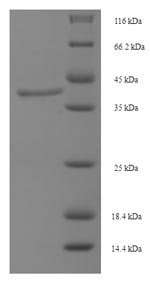This recombinant Human LHCGR protein is typically achieved by the manipulation of LHCGR gene expression in E.coli cells so that it expresses large amounts of a recombinant LHCGR gene. In order to get enough amount of the LHCGR protein, strain selection, codon optimization, fusion systems, co-expression, mutagenesis, and isotope labeling techniques are used. Finally, the LHCGR protein is isolated from the samples such as cell lysates or medium. Protein refolding, cleavage of fusion moieties and chromatography techniques are involved in the protein purification process.
The human LHCGR is a G-protein coupled receptor activated by both human chorionic gonadotropin (hCG) and luteinizing hormone (LH) to function in sexual differentiation in males, ovarian development in females. LHCGR is primarily expressed in ovarian tissues, where it triggers functional responses via cyclic adenosine mononucleotide (cAMP), calcium, and extracellular signal-regulated kinase (ERK) signaling. Appropriate levels of expression of LHCGR are crucial for luteinizing hormone (LH) to regulate ovarian function, including preovulatory steroidogenesis, ovulation, corpus luteum formation, and luteal cell steroidogenesis. Inactive variants of the LHCGR gene lead to Leydig cell hypoplasia (LCH), rare disease and one of the causes of disorder of sexual differentiation (DSD) in males.






